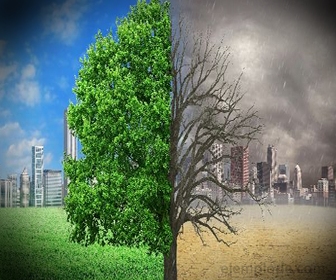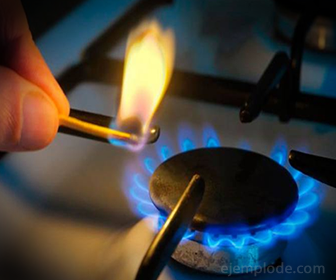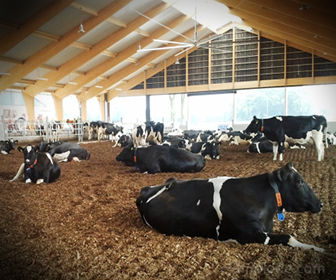Greenhouse gases
Chemistry / / July 04, 2021
The Greenhouse effect is the phenomenon in which the sun's heat is conserved on the planet, thanks to the presence of gases in the atmosphere. It has the beneficial effect that living beings can receive that heat and maintain a well-being.
However, when the amount of certain gases increases too much, so does the conservation of heat, which causes the planet to heat up even more, until it reaches an overheating that can affect life in the Land.
The overheating It is already a reality in many regions of the equatorial countries, which are those that directly receive solar radiation.
The gases that participate in the greenhouse effect are mainly Carbon Monoxide (CO), Methane (CH4), Hydrogen Sulfide (H2S) the group of Sulfur Oxides (SOx's), and the group of Nitrogen Oxides (NOx's).

Carbon Monoxide (CO)
It is an odorless and colorless gas; it is very stable and has a half-life in the atmosphere of 2 to 4 months. It does not appear to have detrimental effects on the surface of materials, and in concentrations below
100 parts per million (ppm, which is equal to mg / L, milligrams per liter) does not produce harmful effects on plants.There are many studies that show that high concentrations of CO can cause physical, pathological, and to death in humans, as it is considered a poison, which when inhaled deprives the body's tissues of oxygen necessary.
The combination of CO leads to the formation of Carboxyhemoglobin (represented by COHb). The combination of Oxygen (O2) and Hemoglobin (Hb) produces Oxyhemoglobin (O2Hb). The Hemoglobin has an affinity for Carbon Monoxide (CO), which is approximately 210 times its affinity for O2.
Fortunately, the formation of Carboxyhemoglobin (COHb) in the bloodstream is a reversible process, and when exposure ceases, Carbon Monoxide (CO) that combined with hemoglobin is released spontaneously, and the blood is free of half of its CO in a period of 3 to 4 hours, in patients healthy.
Carbon Monoxide is mainly produced during incomplete combustions.

Sulfur Oxides (SOx's)
Sulfur Dioxide (SO2) and Sulfur Trioxide (SO3) are the dominant oxides of sulfur present in the atmosphere. Sulfur Dioxide (SO2) is a colorless, non-flammable and non-explosive gas, which produces a taste sensation at concentrations of 0.3 to 1 ppm in air.
At concentrations greater than 3ppm, the gas has a pungent and irritating odor. The SO2 partially converted to SO3 or H2SW4 and its salts through photochemical (chemical processes aided by light) or catalytic processes in the atmosphere.
Sulfur Oxides (SOx's) in combination with particles and air humidity produce the most damaging effects attributed to atmospheric air pollution.
Research indicates that much of the atmospheric haze is due to the formation of various aerosols resulting from photochemical reactions between SO2, particles, Nitrogen Oxides (NOx's) and Hydrocarbons present in the atmosphere. One of the main products of these complex photochemical reactions is the mist droplets of H2SW4 that scatter light.
Sulfur compounds are responsible for the major damage to materials, various species of animals, including man, react with Broncho-Constriction to Sulfur Dioxide (SO2). This effect on the bronchi can be evaluated in terms of increased resistance in the airway.
Nitrogen Oxides (NOx's)
Stable gaseous oxides of Nitrogen include N2O (Nitrous Oxide), NO (Nitric Oxide), N2OR3 (Dinitrogen Trioxide), NO2 (Nitrogen Dioxide) and N2OR5 (Dinitrogen pentoxide). There is also an unstable form, Nitrogen Trioxide (NO3).
Of these, the only ones that are present in the atmosphere in significant quantities are N2O (Nitrous Oxide), NO (Nitric Oxide) and NO2 (Nitrogen dioxide). These three are therefore potential contributors to air pollution and the Greenhouse Effect.
Nitrous Oxide (N2OR): It is an inert gas, with anesthetic characteristics. Its ambient concentration is generally 0.5 ppm (parts per million, equal to milligrams per Liter mg / L) and is below the threshold concentration. It also has a balanced environmental cycle, independent of the other Nitrogen Oxides.
Nitrogen Monoxide (NO): It is a colorless gas, and its environmental concentration is 0.5 ppm (parts per million, equal to milligrams per Liter mg / L), being its biological toxicity insignificant; However, Nitrogen Monoxide (NO) is a precursor to Nitrogen Dioxide (NO2), and it is also an active compound in the formation of Photochemical Fog, therefore, it initiates reactions that produce air pollutants. Therefore, the control of Nitrogen Monoxide is important in reducing Air Pollution and the Greenhouse Effect.
Nitrogen Dioxide (NO2): It is a reddish brown gas and is highly visible when present in sufficient quantity; a concentration of 1ppm can be detected with the naked eye.
Methane (CH4)
In Organic Chemistry, Methane is the simplest compound, made up of one Carbon atom and four Hydrogen atoms (CH4). When exposed in the air to a spark or a good amount of heat, it decomposes in a combustion, producing Carbon Dioxide (CO2) and Water vapor (H2OR).
CH4 + O2 -> CO2 + H2O + Heat
It is observed that this reaction generates heat. That is why the excessive presence of Methane (CH4) in the air is dangerous, due to the heat it produces, which will add even more to that generated in the greenhouse effect.
Methane (CH4) is produced by animal physiology. When animals eat and decompose food in their bodies, they release Methane as a product. That's why the cattle stables are great sources of this gas, by the gases released by large livestock.
The same happens with the human being, who at the end of the digestion is releasing a mixture of gases where there is a quantity of Methane.

Hydrogen Sulfide (H2S)
Hydrogen Sulfide (H2S) is a colorless gas with a characteristic rotten egg odor. It is another of those that generate a great impact, both in air pollution and in the greenhouse effect. It is dangerous because when it dissolves in the water particles it becomes corrosive and participates in acid rain.
It occurs in the rotting of organic matter containing sulfur compounds.
Examples of Greenhouse Gases
Carbon Monoxide (CO)
Methane (CH4)
Sulfur Dioxide (SO2)
Sulfur trioxide (SO3)
Nitrous Oxide (N2OR)
Nitric Oxide (NO)
Dinitrogen Trioxide (N2OR3)
Nitrogen Dioxide (NO2)
Dinitrogen pentoxide (N2OR5)
Dinitrogen Heptoxide (N2OR7)



